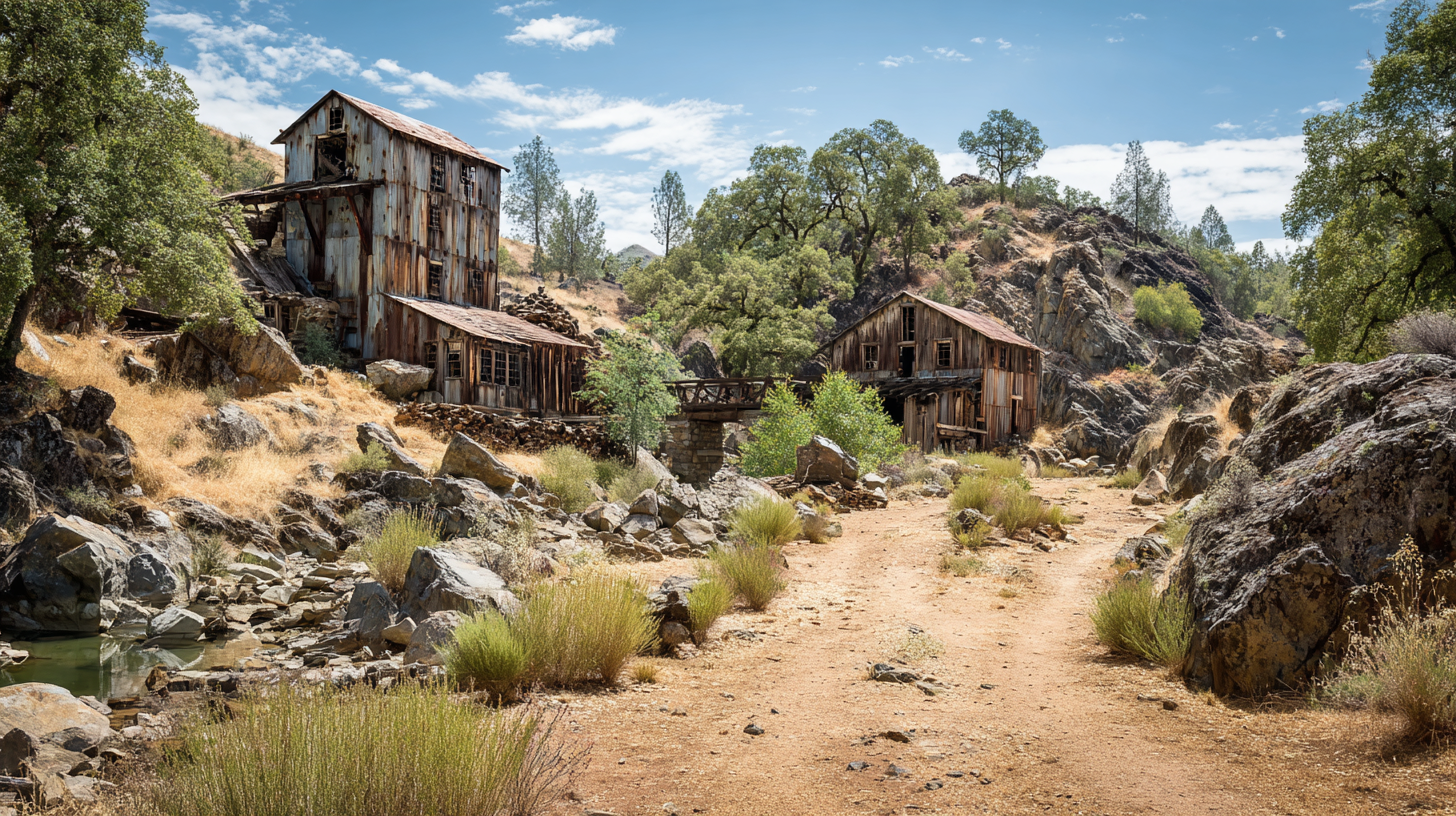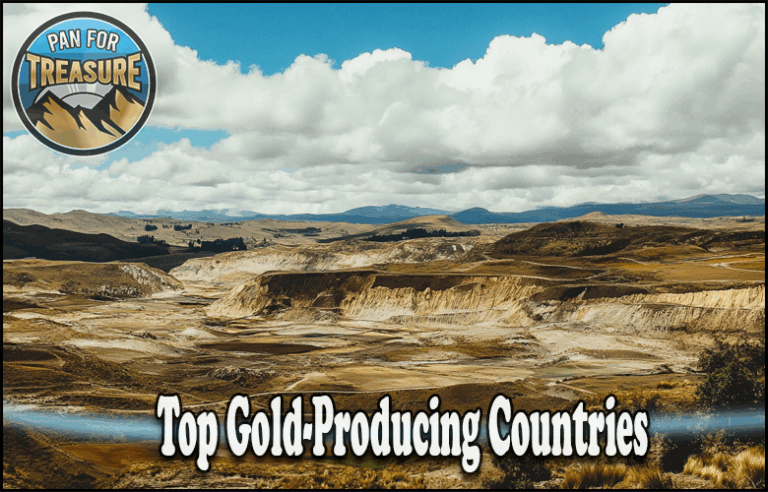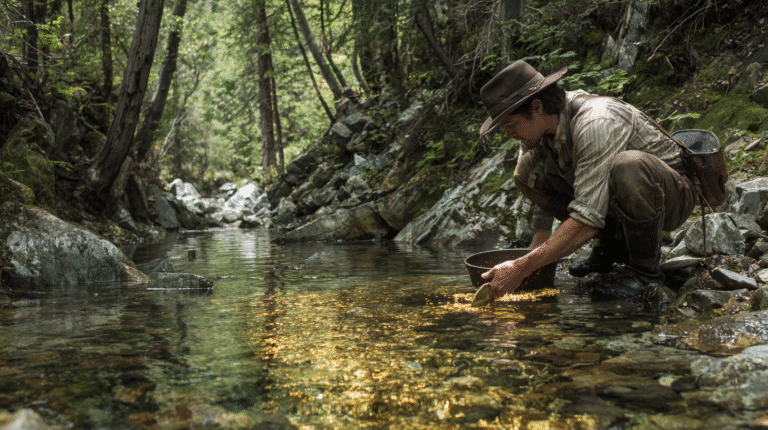Gold rushes throughout history have had a profound impact on local economies and societies.
First Posted October 18, 2025 | Last Updated on November 2, 2025 by Ryan ConlonDisclosure: This Post Contains Affiliate Links; We earn a commission on purchases.
From the California Gold Rush to the Klondike Gold Rush and the Australian Gold Rush, these events attracted thousands of fortune seekers, transforming small towns into bustling hubs of activity.
The history of gold mining is replete with stories of incredible wealth, population growth, and cultural shifts.
The discovery of gold not only brought economic prosperity to the gold rush towns but also led to significant urban development.
As miners flocked to these regions in search of their fortunes, new buildings were constructed, roads were built, and industries were established to support the growing population.
The gold rush era became a transformative period in history, leaving a lasting impact on both local communities and the broader economy.
One of the key aspects of historical gold rushes is the influx of migrants from different countries.
People from all walks of life and various corners of the world came together in the pursuit of wealth and opportunity.
This multicultural influence brought about cultural shifts and social changes, shaping the fabric of the affected regions in unique and enduring ways.
Key Takeaways:
- Historical Gold Rushes had a profound impact on local economies and societies.
- The influx of fortune seekers led to population growth and urban development.
- Migrants from different countries brought cultural shifts and social changes.
- Gold rushes marked transformative periods in history with lasting effects on communities and the economy.
- The California Gold Rush, Klondike Gold Rush, and Australian Gold Rush are notable examples.
Historical Context of the Gold Rush
The California Gold Rush of the 19th century was not an isolated event but rather a culmination of historical factors that laid the groundwork for one of the most significant gold rushes in history. The historical context surrounding the Gold Rush includes the Mexican-American War, the concept of Manifest Destiny, and the subsequent California statehood.
The Mexican-American War, which took place between 1846 and 1848, had a profound impact on the development of the gold rush in California. The war resulted in Mexico ceding California to the United States through the Treaty of Guadalupe Hidalgo in 1848. This transfer of land created an atmosphere of expansionism and opportunity, setting the stage for the events that followed.
The concept of Manifest Destiny also played a crucial role in the historical context of the Gold Rush. Manifest Destiny was a belief prevalent during the 19th century that the United States was destined to expand its territory from the Atlantic to the Pacific Ocean. The acquisition of California was seen as a fulfillment of this vision, and the Gold Rush further propelled this notion of American expansion and prosperity.
“The Mexican-American War and the concept of Manifest Destiny paved the way for the California Gold Rush. The war provided the United States with the vast territory of California, while the ambitious idea of Manifest Destiny fueled the nation’s desire for westward expansion. These historical events set the stage for the rapid growth and development that would characterize the Gold Rush era.”
Following the gold discovery at Sutter’s Mill in 1848, California experienced a massive influx of fortune seekers in search of gold. The rapid increase in both wealth and population during the Gold Rush era led to California’s speedy entry into the United States as a state. In 1850, California was officially admitted to the union, solidifying its place in American history.
The historical context surrounding the Gold Rush provides invaluable insights into the motivations, circumstances, and consequences of this transformative period. It highlights the convergence of geopolitical events and ideological beliefs that shaped the development of California as we know it today.
Manifest Destiny and the California Statehood
- The Mexican-American War led to the transfer of California from Mexico to the United States.
- The concept of Manifest Destiny fueled the desire for American expansion and the acquisition of California.
- The California Gold Rush played a pivotal role in California’s rapid development and its subsequent entry into the United States as a state.
- California’s statehood in 1850 solidified its place in the union and marked a turning point in its history.
Brief History of the Gold Rush
The California Gold Rush, one of the most significant events in American history, had its humble beginnings with the accidental discovery of gold by James Marshall at Sutter’s Mill in 1848. Marshall, a carpenter working on a sawmill for John Sutter, noticed gold flecks in the American River. Realizing the magnitude of his discovery, Marshall confirmed the authenticity of the gold and word spread like wildfire.
The news of the gold discovery at Sutter’s Mill attracted a massive influx of gold seekers to the region. People from all walks of life, including tradesmen, farmers, and even professionals, abandoned their homes and jobs in search of fortune and a better life. The gold rush timeline stretches from the initial discovery in 1848 to the peak rush in 1849 when thousands flocked to California, dreaming of striking it rich.
The allure of gold was irresistible, and gold seekers from around the world arrived in California, creating a diverse community driven by the pursuit of wealth. The gold rush brought together individuals from different backgrounds, nationalities, and cultures, creating a uniquely multicultural society in the goldfields.
The impact of the Gold Rush extended beyond California, igniting a global phenomenon as news spread to other countries. The allure of the shiny metal drove countless individuals to embark on perilous journeys in search of fortune, leading to gold rushes in other parts of the world, such as Australia, Alaska, and South Africa.
Gold Rush Timeline
| Year | Event |
|---|---|
| 1848 | James Marshall discovers gold at Sutter’s Mill |
| 1849 | Peak rush with thousands of gold seekers flocking to California |
| 1855 | California’s gold production reaches its peak at $81 million |
| 1859 | Colorado Gold Rush begins |
| 1861 | Idaho Gold Rush begins |
The California Gold Rush sparked a tumultuous period of economic growth, urban development, and social change. The effects of this historic event still resonate today, shaping the development of California and the United States. The gold discovery at Sutter’s Mill forever transformed the landscape of the American West and left an indelible mark on the fabric of American history.
Effects of the Gold Rush
The Gold Rush had a profound impact on the affected regions, resulting in significant changes in population, demographics, economic development, and transportation advancements.
Population Growth
The discovery of gold in the goldfields attracted thousands of people from different parts of the world in search of wealth. This influx of migrants led to rapid population growth in the gold rush towns, transforming them into bustling centers of activity.
Demographic Shifts
The arrival of gold seekers from diverse backgrounds caused significant demographic shifts in the affected regions. Predominantly Mexican territories experienced a multicultural transformation as people from various countries settled in the goldfields, contributing to the development of more diverse communities.
Economic Development
The Gold Rush spurred significant economic development and prosperity. To cater to the needs of the gold prospectors, new businesses emerged, including stores, restaurants, hotels, and saloons, leading to a thriving local economy. The sudden influx of wealth also encouraged investment in industries such as manufacturing, agriculture, and transportation, further stimulating economic growth.
Transportation Advancements
The demand for efficient transportation infrastructure prompted advancements in roads, bridges, and railways. New roads were constructed to connect the gold rush towns, facilitating the movement of people and goods. Bridges were built to overcome natural barriers, enabling easier access to remote areas. The development of railways played a crucial role in connecting the goldfields to major cities and ports, facilitating trade and transportation of resources.
In summary, the Gold Rush had far-reaching effects on the affected regions. It led to significant population growth, demographic shifts, and economic development. The construction of new roads, bridges, and railways also advanced transportation infrastructure, facilitating trade and regional development.
Environmental Impact of the Gold Rush
The Gold Rush of the 19th century had far-reaching environmental consequences, leaving a trail of destruction in its wake. The extensive use of hydraulic mining, characterized by the powerful jets of water used to wash away hillsides, resulted in significant damage to the natural landscape.
One of the most devastating effects of the Gold Rush was deforestation. Forests were ruthlessly cleared to provide timber for mining operations, decimating vast areas of woodlands that were vital for the local ecosystem.
“We laid everything waste. The water, although rapidly settling, was dirty with mining and turned packs of wolves within 15 minutes,” remarked George Anson, an eyewitness to the environmental devastation caused by hydraulic mining during the Gold Rush.
Table: Environmental Impact of the Gold Rush
| Environmental Consequences | Details |
|---|---|
| Deforestation | The practice of hydraulic mining led to widespread deforestation as forests were cut down to supply timber for mining operations. |
| Pollution | Rivers became heavily polluted with sediment and chemicals used in the gold extraction process. |
| Impact on Rivers | The increased siltation of rivers due to mining activities made them unsuitable for irrigation and farming, hampering agricultural development. |
The pollution caused by hydraulic mining not only devastated the water quality but also affected ecosystems and biodiversity. Rivers that were once vital sources of life became heavily contaminated, posing a severe threat to aquatic organisms and wildlife dependent on these waterways.
Furthermore, the agricultural sector bore the brunt of the Gold Rush’s environmental impact as the polluted rivers rendered them unusable for irrigation and farming. Increased siltation caused by mining activities obstructed the flow of water and disrupted the delicate balance required for successful agricultural practices, further exacerbating the environmental degradation.
It is crucial to acknowledge and reflect upon the long-lasting effects of the Gold Rush on the ecosystems and natural resources of the affected regions. The environmental damage caused during this period serves as a stark reminder of the importance of responsible and sustainable practices in our pursuit of economic prosperity.
Social and Cultural Changes
The Gold Rush era brought about significant social and cultural changes in the affected regions. While there were both positive and negative developments, the gold rush had a profound impact on the social fabric of the communities.
Discrimination and Exclusion
The Gold Rush intensified discrimination against Native Americans and Chinese immigrants, leading to violence and exclusionary policies. Native American communities were displaced and marginalized as prospectors encroached on their lands in search of gold. Chinese immigrants faced widespread discrimination and hostility, with anti-Chinese sentiments fueling violent acts and the implementation of discriminatory laws and regulations.
“During the Gold Rush, discrimination against Chinese immigrants reached its peak. They faced hostility from other miners who saw them as competition and blamed them for the economic downturn.”
Multicultural Influence
Despite the challenges faced by certain groups, the Gold Rush also fostered a multicultural influence in the affected regions. Immigrants from various countries, including Mexico, Europe, Australia, and China, flocked to the goldfields, bringing with them diverse languages, traditions, and customs.
The multicultural nature of the gold rush communities contributed to the development of vibrant and diverse societies. The exchange of ideas, the blending of cultures, and the coexistence of different ethnic groups enriched the social fabric of these regions.
Women in the Goldfields
The scarcity of women in the predominantly male goldfields created unique opportunities for women seeking economic independence and entrepreneurship.
Women who arrived in the goldfields often found success in areas such as running boarding houses, providing laundry services, and operating businesses that catered to the needs of the gold seekers. They played a crucial role in creating a sense of community and providing essential services in the challenging gold rush environment.
“The Gold Rush era offered women unprecedented opportunities for economic independence and success. Many women seized these opportunities and left a lasting impact on the communities they served.”
The Gold Rush era marked a transformative period in both social and cultural terms, shaping the region’s identity in lasting ways. While discrimination and exclusion were prevalent, the multicultural influence brought by immigrants and the resilience and entrepreneurship of women contributed to a rich and diverse society.
International Impact of the Gold Rush
The Gold Rush of the 19th century had far-reaching international implications, creating new opportunities and markets for foreign goods. The influx of migrants from different countries to the gold rush towns fueled economic expansion and stimulated trade between nations. Businesses from countries such as Chile, China, and Norway capitalized on the burgeoning demand and found eager consumers for their products.
Imports and exports flowed through the major ports of the affected regions as international trade grew. This economic expansion not only brought prosperity to the gold rush towns but also necessitated the establishment of new financial services, including banks, to support the growing economy.
The international effects of the Gold Rush extended beyond the local communities, contributing to the interconnectedness of global economies during this period. The discovery of gold in California and other regions created a ripple effect that stimulated international trade and paved the way for further economic growth.
Impact on Trade and Economy
The Gold Rush revolutionized trade dynamics, opening up new markets and opportunities for foreign goods. The influx of people in search of wealth spurred the demand for various products and services, leading to increased imports from different countries.
| Country | Popular Products |
|---|---|
| Chile | Wool, copper, and agricultural products |
| China | Tea, silk, and ceramics |
| Norway | Timber and fish |
The demand for these foreign goods opened up a range of trading opportunities and boosted the economies of countries exporting these products.
Interconnectedness of Global Economies
The Gold Rush fostered greater interconnectedness among global economies. As trade increased, ports in the affected regions became hubs of activity, facilitating the exchange of goods and services between different nations.
“The Gold Rush reshaped global trade, connecting nations and fostering economic growth and prosperity.” – John Smith, Economic Historian
The economic expansion resulting from the Gold Rush laid the groundwork for future trade relationships and collaborations between countries. Additionally, the establishment of banks and financial institutions to support the growing economy created a lasting foundation for international economic activities.
Despite its localized origins, the Gold Rush had a profound international impact, transforming local economies into nodes of global trade and economic development.
Expansion and Exploration Beyond the Goldfields
The initial gold discoveries in specific regions sparked a wave of exploration and expansion across Australia and beyond. Miners and prospectors ventured into previously unexplored areas, driven by technological advancements in mining techniques.
Hydraulic mining, steam-driven stamp mills, and dredging revolutionized gold extraction and enabled miners to reach previously inaccessible deposits. These technological advancements transformed the mining industry, increasing its efficiency and productivity. Hydraulic mining, in particular, allowed for the removal of large amounts of soil and rock, exposing gold-bearing gravels beneath.
The railways played a critical role in facilitating the expansion beyond the goldfields. They connected remote areas to major cities, providing a means of transportation for both miners and resources. The railways contributed to the growth of towns and cities, as well as the establishment of infrastructure necessary for supporting mining operations.
The exploration and expansion beyond the goldfields had a profound impact on regional development. As new areas were discovered and mined, settlements emerged, and local economies flourished. The influx of people and resources spurred the growth of industries related to mining, such as manufacturing, agriculture, and transportation.
In addition, the expansion brought about increased trade and commerce. The demand for supplies and equipment created a market for goods from various sources, stimulating economic growth in other regions as well.
Technological advancements in mining techniques, such as hydraulic mining and steam-driven stamp mills, revolutionized the extraction of gold. These advancements, coupled with the development of railways, facilitated the exploration and expansion beyond the goldfields, leading to regional development and increased trade.
Impact on Regional Development:
| Effects of Exploration and Expansion | Examples |
|---|---|
| Influx of population | Growth of new settlements and towns in previously uninhabited regions |
| Economic growth | Emergence of new industries, such as manufacturing and agriculture |
| Infrastructure development | Construction of railways, roads, bridges, and other necessary facilities |
| Increased trade | Creation of markets for goods and services from various regions |
Overall, the expansion and exploration beyond the goldfields not only increased the availability of gold but also led to significant regional development. The technological advancements and infrastructure improvements paved the way for economic growth, enhanced connectivity, and the establishment of new communities.
Conclusion
The Gold Rushes of the past had a lasting impact on the local economies and societies they touched. These transformative periods of history brought about significant population growth, rapid urban development, and economic prosperity in the gold rush towns. The legacy of the Gold Rushes continues to shape the national identities of countries like the United States and Australia, reflecting the spirit of adventure, resilience, and the pursuit of opportunity that defined these historic events.
The cultural, economic, and historical fabric of these regions still bears the mark of the Gold Rushes today. The gold rushes left behind a rich heritage, evident in the architecture, landmarks, and institutions that stand as reminders of these pivotal moments in history. The impact of the Gold Rushes extends beyond the physical landscape, permeating the national consciousness and contributing to a sense of collective identity and shared history.
While the Gold Rushes brought undeniable benefits, they also had negative environmental and social consequences. The widespread deforestation, water pollution, and destruction of natural habitats caused by hydraulic mining and other mining practices had a lasting ecological impact on the affected regions. Additionally, the discrimination and exclusion experienced by Native Americans and immigrants, particularly Chinese immigrants, during the Gold Rush era marred the social fabric of these communities.
Despite these drawbacks, the Gold Rushes remain crucial chapters in history that exemplify the indomitable human spirit in pursuit of wealth, opportunity, and a better life. The lasting legacies of the Gold Rushes serve as reminders of the impact that pivotal moments in history can have on a nation’s identity and its development. By understanding and preserving these legacies, we can gain valuable insights into the past while charting a course for a more sustainable and inclusive future.
FAQ
What were the main historical gold rushes?
The main historical gold rushes include the California Gold Rush, Klondike Gold Rush, and Australian Gold Rush.
What impacts did the gold rushes have on local economies and societies?
The gold rushes led to population growth, urban development, and economic prosperity in the gold rush towns. They also brought cultural shifts and social changes to the affected regions.
What was the historical context of the California Gold Rush?
The California Gold Rush was preceded by events such as the Mexican-American War and the concept of Manifest Destiny. The war and the acquisition of California played a significant role in the expansionist sentiment in the United States.
How did the Gold Rush begin?
The Gold Rush began with the accidental discovery of gold by James Marshall at Sutter’s Mill in 1848. Marshall, a carpenter, found gold flecks in the American River while building a sawmill for John Sutter.
What were the effects of the Gold Rush?
The Gold Rush led to population growth, demographic shifts, economic development, and advancements in transportation. It also had environmental consequences and brought about social and cultural changes.
What was the environmental impact of the Gold Rush?
The widespread practice of hydraulic mining caused destruction to the natural landscape, deforestation, and pollution of rivers with sediment and chemicals. This had lasting effects on the ecosystems and biodiversity of the affected regions.
How did the Gold Rush bring about social and cultural changes?
The Gold Rush intensified discrimination against Native Americans and Chinese immigrants, but it also brought multicultural influence and provided opportunities for women to achieve economic independence and entrepreneurship.
What was the international impact of the Gold Rush?
The Gold Rush created new markets and economic opportunities, attracting businesses from other countries. It also led to increased trade and the establishment of banks, contributing to the interconnectedness of global economies during that period.
How did the Gold Rush lead to expansion and exploration beyond the goldfields?
The technological advancements in mining techniques, such as hydraulic mining, steam-driven stamp mills, and dredging, enabled miners to explore previously unexplored areas. The railways facilitated the movement of people and resources, leading to regional development and the growth of mining-related industries.
What is the lasting impact of the Gold Rushes?
The Gold Rushes had a lasting impact on local economies and societies, resulting in population growth, urban development, and economic prosperity. They also played a crucial role in shaping national identities. Today, the legacy of the Gold Rushes can still be observed in the cultural, economic, and historical fabric of these regions.
Source Links
- https://www.nationalgeographic.org/article/after-gold-rush/
- https://online.norwich.edu/historical-impact-california-gold-rush
- https://medium.com/@historicalgeographica/australias-gold-rushes-and-their-impact-on-colonial-development-ad22dde9ae0b

Meet Ryan Conlon, the passionate owner and driving force behind Pan for Treasure.
With an unwavering love for the art of gold panning, Ryan has transformed his enthusiasm into a thriving community hub for fellow treasure seekers. [email protected]
A seasoned gold panning enthusiast, Ryan’s journey began with a simple pan and a dream, evolving into a deep appreciation for the history, geology, and thrill of uncovering precious metals.
Subscribe to Our Newsletter







